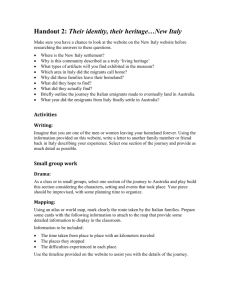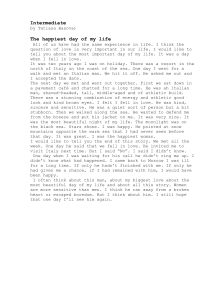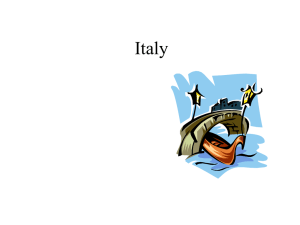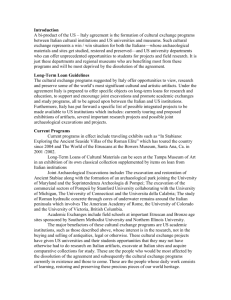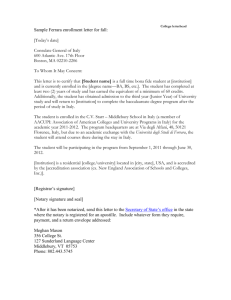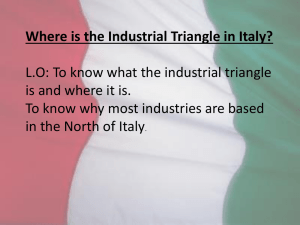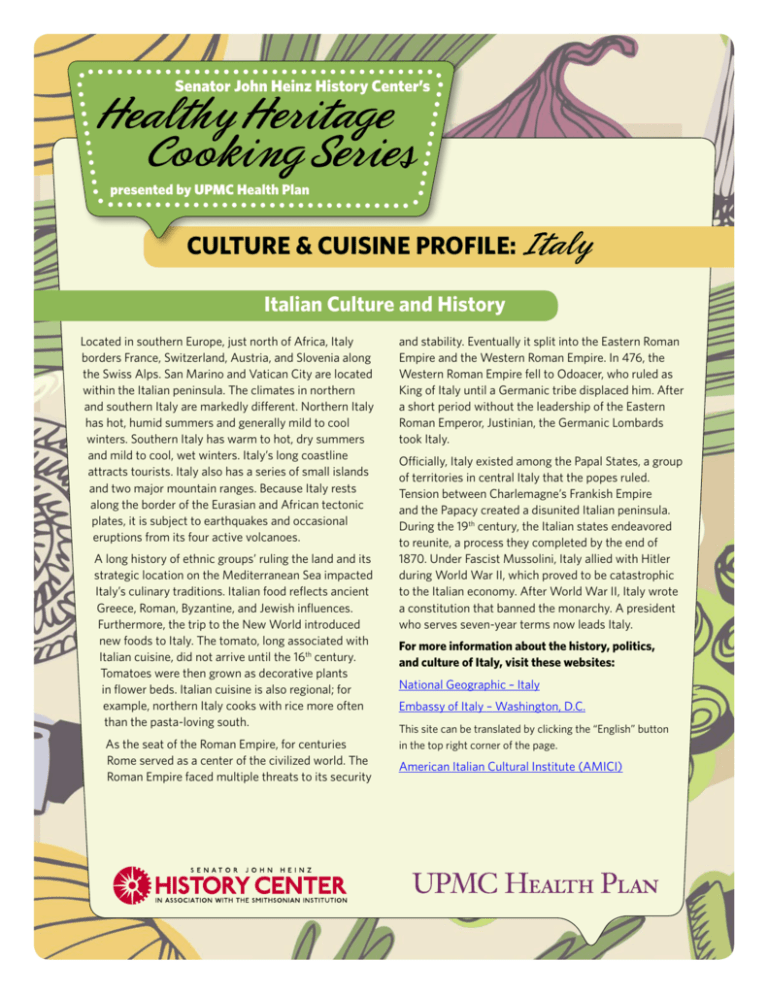
Senator John Heinz History Center’s
Healthy Heritage
CookingSeries
presented by UPMC Health Plan
CULTURE & CUISINE PROFILE: Italy
Italian Culture and History
Located in southern Europe, just north of Africa, Italy
borders France, Switzerland, Austria, and Slovenia along
the Swiss Alps. San Marino and Vatican City are located
within the Italian peninsula. The climates in northern
and southern Italy are markedly different. Northern Italy
has hot, humid summers and generally mild to cool
winters. Southern Italy has warm to hot, dry summers
and mild to cool, wet winters. Italy’s long coastline
attracts tourists. Italy also has a series of small islands
and two major mountain ranges. Because Italy rests
along the border of the Eurasian and African tectonic
plates, it is subject to earthquakes and occasional
eruptions from its four active volcanoes.
A long history of ethnic groups’ ruling the land and its
strategic location on the Mediterranean Sea impacted
Italy’s culinary traditions. Italian food reflects ancient
Greece, Roman, Byzantine, and Jewish influences.
Furthermore, the trip to the New World introduced
new foods to Italy. The tomato, long associated with
Italian cuisine, did not arrive until the 16th century.
Tomatoes were then grown as decorative plants
in flower beds. Italian cuisine is also regional; for
example, northern Italy cooks with rice more often
than the pasta-loving south.
As the seat of the Roman Empire, for centuries
Rome served as a center of the civilized world. The
Roman Empire faced multiple threats to its security
and stability. Eventually it split into the Eastern Roman
Empire and the Western Roman Empire. In 476, the
Western Roman Empire fell to Odoacer, who ruled as
King of Italy until a Germanic tribe displaced him. After
a short period without the leadership of the Eastern
Roman Emperor, Justinian, the Germanic Lombards
took Italy.
Officially, Italy existed among the Papal States, a group
of territories in central Italy that the popes ruled.
Tension between Charlemagne’s Frankish Empire
and the Papacy created a disunited Italian peninsula.
During the 19th century, the Italian states endeavored
to reunite, a process they completed by the end of
1870. Under Fascist Mussolini, Italy allied with Hitler
during World War II, which proved to be catastrophic
to the Italian economy. After World War II, Italy wrote
a constitution that banned the monarchy. A president
who serves seven-year terms now leads Italy.
For more information about the history, politics,
and culture of Italy, visit these websites:
National Geographic – Italy
Embassy of Italy – Washington, D.C.
This site can be translated by clicking the “English” button
in the top right corner of the page.
American Italian Cultural Institute (AMICI)
CULTURE & CUISINE PROFILE: Italy
Italian Cuisine
ABOUT: The Mediterranean Diet
Health Properties of Tomatoes
Did you know that Italy has one of the lowest adult
obesity rates of all 27 countries in the European Union?*
While there are many lifestyle factors that contribute
to the health of this region, the average Italian’s diet is
certainly one of them.
Academy of Nutrition and Dietetics, Recommended
Cookbook: The Italian Diet, by Gino D’Acampo
Known broadly as the “Mediterranean Diet,” dishes
eaten in Italy and around the Mediterranean are
served in small portions and include much more than
just pasta. In fact, heavy dishes of pizza, pasta, and
large cuts of meat are not typically the focal point of
a meal. More attention is paid to filling plates with
fresh vegetables seasoned with the Italian trio of herbs
(basil, oregano and parsley), lean fish, and a light
drizzle of heart-healthy extra virgin olive oil or a bit of
cheese just for flavor. Fresh, whole fruit is often served
for dessert. Meals are enjoyed slowly with family. Very
few processed or refined foods make it to a traditional
Italian table, thereby making a colorful and appetizing
spread and ensuring a high level of nutrition.
You don’t need a summer garden to whip up this
delicious salad, chock full of fresh veggies. Just visit
the produce aisle of your local grocery store. Bellisimo!
Click here to view the recipe.
*According to the World Health Organization (WHO)
Global InfoBase.
Check out these links for more information:
Everything You Need to Know About the
Mediterranean Diet
RECIPE: Summer Tomato, Onion, and
Cucumber Salad
ADDITIONAL HEALTH RESOURCES
Download the Healthy Heritage Cooking Series recipe
cards at www.heinzhistorycenter.org. The back of
each card outlines health benefits of key ingredients
commonly used in ethnic cuisines and tips for cooking
healthier.
Watch videos of Healthy Heritage Cooking Series
sessions at www.youtube.com/upmchealthplan.
Check out UPMC Health Plan’s Health & History
Pinterest Board, with photos of historic “firsts” in
Pittsburgh that positively impacted health care.
www.pinterest.com/upmchealthplan
UPMC Health Plan’s partnership with the
Senator John Heinz History Center for the
Healthy Heritage Cooking Series supports
We Can! Pittsburgh, a local arm of the National
Institutes of Health’s We Can! Ways to Enhance
Children’s Activity & Nutrition® program.
We Can! Pittsburgh aims to reduce the
prevalence of childhood obesity by educating parents and caregivers of
children ages 8-13 about improving nutrition, increasing physical activity,
and reducing screen time (e.g., TV, video games, computers). Download
We Can! materials at http://www.upmchealthplan.com/about/wecan.html
or www.nih.gov/wecan.
Pittsburgh
We Can! Ways to Enhance Children’s Activity & Nutrition, We Can!, and the
We Can! logos are registered trademarks of the U.S. Department of Health
& Human Services (DHHS).
Copyright 2013 UPMC Health Plan, Inc. All rights reserved.
HH ITALIAN PROFILE C20130325-15 (SD) 4/25/13
#healthyheritagecooking

